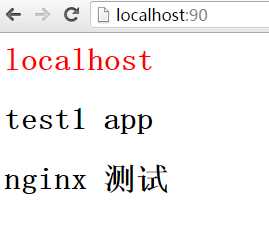标签:
1.下载 nginx
2.配置nginx 文件
1)配置该目录下E:\nginx\nginx-1.9.3\conf:
#user nobody; worker_processes 1; #error_log logs/error.log; #error_log logs/error.log notice; #error_log logs/error.log info; #pid logs/nginx.pid; events { worker_connections 1024; } http { include mime.types; default_type application/octet-stream; #log_format main ‘$remote_addr - $remote_user [$time_local] "$request" ‘ # ‘$status $body_bytes_sent "$http_referer" ‘ # ‘"$http_user_agent" "$http_x_forwarded_for"‘; #access_log logs/access.log main; sendfile on; #tcp_nopush on; #keepalive_timeout 0; keepalive_timeout 65; #gzip on; upstream localhost { server 127.0.0.1:80 weight=1; server 127.0.0.1:82 weight=2; } server { listen 90; server_name localhost; #charset koi8-r; #access_log logs/host.access.log main; location / { proxy_pass http://localhost; proxy_redirect default; } #error_page 404 /404.html; # redirect server error pages to the static page /50x.html # error_page 500 502 503 504 /50x.html; location = /50x.html { root html; } # proxy the PHP scripts to Apache listening on 127.0.0.1:80 # #location ~ \.php$ { # proxy_pass http://127.0.0.1; #} # pass the PHP scripts to FastCGI server listening on 127.0.0.1:9000 # #location ~ \.php$ { # root html; # fastcgi_pass 127.0.0.1:9000; # fastcgi_index index.php; # fastcgi_param SCRIPT_FILENAME /scripts$fastcgi_script_name; # include fastcgi_params; #} # deny access to .htaccess files, if Apache‘s document root # concurs with nginx‘s one # #location ~ /\.ht { # deny all; #} } # another virtual host using mix of IP-, name-, and port-based configuration # #server { # listen 8000; # listen somename:8080; # server_name somename alias another.alias; # location / { # root html; # index index.html index.htm; # } #} # HTTPS server # #server { # listen 443 ssl; # server_name localhost; # ssl_certificate cert.pem; # ssl_certificate_key cert.key; # ssl_session_cache shared:SSL:1m; # ssl_session_timeout 5m; # ssl_ciphers HIGH:!aNULL:!MD5; # ssl_prefer_server_ciphers on; # location / { # root html; # index index.html index.htm; # } #} }
3.在iis中部署两个网站分别为:127.0.0.1:80 ,127.0.0.1:82
4.效果如下:


nginx相关使用命令:
验证配置是否正确: nginx -t
查看Nginx的版本号:nginx -V
启动Nginx:start nginx
快速停止或关闭Nginx:nginx -s stop
正常停止或关闭Nginx:nginx -s quit
配置文件修改重装载命令:nginx -s reload
在此记录下Nginx服务器nginx.conf的配置文件说明, 部分注释收集与网络.
#运行用户
user www-data;
#启动进程,通常设置成和cpu的数量相等
worker_processes 1;#全局错误日志及PID文件
error_log /var/log/nginx/error.log;
pid /var/run/nginx.pid;#工作模式及连接数上限
events {
use epoll; #epoll是多路复用IO(I/O Multiplexing)中的一种方式,但是仅用于linux2.6以上内核,可以大大提高nginx的性能
worker_connections 1024;#单个后台worker process进程的最大并发链接数
# multi_accept on;
}#设定http服务器,利用它的反向代理功能提供负载均衡支持
http {
#设定mime类型,类型由mime.type文件定义
include /etc/nginx/mime.types;
default_type application/octet-stream;
#设定日志格式
access_log /var/log/nginx/access.log;#sendfile 指令指定 nginx 是否调用 sendfile 函数(zero copy 方式)来输出文件,对于普通应用,
#必须设为 on,如果用来进行下载等应用磁盘IO重负载应用,可设置为 off,以平衡磁盘与网络I/O处理速度,降低系统的uptime.
sendfile on;
#tcp_nopush on;#连接超时时间
#keepalive_timeout 0;
keepalive_timeout 65;
tcp_nodelay on;
#开启gzip压缩
gzip on;
gzip_disable "MSIE [1-6]\.(?!.*SV1)";#设定请求缓冲
client_header_buffer_size 1k;
large_client_header_buffers 4 4k;include /etc/nginx/conf.d/*.conf;
include /etc/nginx/sites-enabled/*;#设定负载均衡的服务器列表
upstream mysvr {
#weigth参数表示权值,权值越高被分配到的几率越大
#本机上的Squid开启3128端口
server 192.168.8.1:3128 weight=5;
server 192.168.8.2:80 weight=1;
server 192.168.8.3:80 weight=6;
}
server {
#侦听80端口
listen 80;
#定义使用www.xx.com访问
server_name www.xx.com;#设定本虚拟主机的访问日志
access_log logs/www.xx.com.access.log main;#默认请求
location / {
root /root; #定义服务器的默认网站根目录位置
index index.php index.html index.htm; #定义首页索引文件的名称fastcgi_pass www.xx.com;
fastcgi_param SCRIPT_FILENAME $document_root/$fastcgi_script_name;
include /etc/nginx/fastcgi_params;
}# 定义错误提示页面
error_page 500 502 503 504 /50x.html;
location = /50x.html {
root /root;
}#静态文件,nginx自己处理
location ~ ^/(images|javascript|js|css|flash|media|static)/ {
root /var/www/virtual/htdocs;
#过期30天,静态文件不怎么更新,过期可以设大一点,如果频繁更新,则可以设置得小一点。
expires 30d;
}
#PHP 脚本请求全部转发到 FastCGI处理. 使用FastCGI默认配置.
location ~ \.php$ {
root /root;
fastcgi_pass 127.0.0.1:9000;
fastcgi_index index.php;
fastcgi_param SCRIPT_FILENAME /home/www/www$fastcgi_script_name;
include fastcgi_params;
}
#设定查看Nginx状态的地址
location /NginxStatus {
stub_status on;
access_log on;
auth_basic "NginxStatus";
auth_basic_user_file conf/htpasswd;
}
#禁止访问 .htxxx 文件
location ~ /\.ht {
deny all;
}
}
}
以上是一些基本的配置,使用Nginx最大的好处就是负载均衡
如果要使用负载均衡的话,可以修改配置http节点如下:
#设定http服务器,利用它的反向代理功能提供负载均衡支持
http {
#设定mime类型,类型由mime.type文件定义
include /etc/nginx/mime.types;
default_type application/octet-stream;
#设定日志格式
access_log /var/log/nginx/access.log;#省略上文有的一些配置节点
#。。。。。。。。。。
#设定负载均衡的服务器列表
upstream mysvr {
#weigth参数表示权值,权值越高被分配到的几率越大
server 192.168.8.1x:3128 weight=5;#本机上的Squid开启3128端口
server 192.168.8.2x:80 weight=1;
server 192.168.8.3x:80 weight=6;
}upstream mysvr2 {
#weigth参数表示权值,权值越高被分配到的几率越大server 192.168.8.x:80 weight=1;
server 192.168.8.x:80 weight=6;
}#第一个虚拟服务器
server {
#侦听192.168.8.x的80端口
listen 80;
server_name 192.168.8.x;#对aspx后缀的进行负载均衡请求
location ~ .*\.aspx$ {root /root; #定义服务器的默认网站根目录位置
index index.php index.html index.htm; #定义首页索引文件的名称proxy_pass http://mysvr ;#请求转向mysvr 定义的服务器列表
#以下是一些反向代理的配置可删除.
proxy_redirect off;
#后端的Web服务器可以通过X-Forwarded-For获取用户真实IP
proxy_set_header Host $host;
proxy_set_header X-Real-IP $remote_addr;
proxy_set_header X-Forwarded-For $proxy_add_x_forwarded_for;
client_max_body_size 10m; #允许客户端请求的最大单文件字节数
client_body_buffer_size 128k; #缓冲区代理缓冲用户端请求的最大字节数,
proxy_connect_timeout 90; #nginx跟后端服务器连接超时时间(代理连接超时)
proxy_send_timeout 90; #后端服务器数据回传时间(代理发送超时)
proxy_read_timeout 90; #连接成功后,后端服务器响应时间(代理接收超时)
proxy_buffer_size 4k; #设置代理服务器(nginx)保存用户头信息的缓冲区大小
proxy_buffers 4 32k; #proxy_buffers缓冲区,网页平均在32k以下的话,这样设置
proxy_busy_buffers_size 64k; #高负荷下缓冲大小(proxy_buffers*2)
proxy_temp_file_write_size 64k; #设定缓存文件夹大小,大于这个值,将从upstream服务器传}
}
}
标签:
原文地址:http://www.cnblogs.com/zoro-zero/p/5752668.html